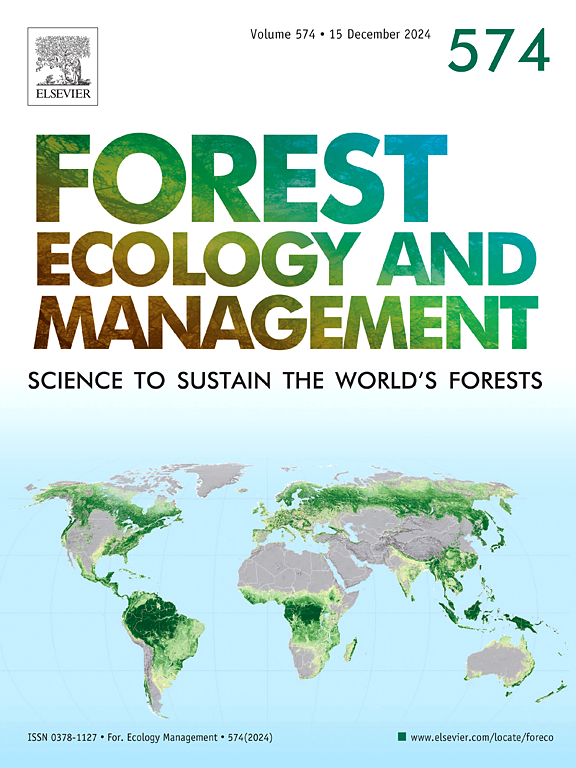Mixed plantations promote carbon accumulation in plants and soil in arid and semi-arid regions: Evidence from the Loess Plateau of China
IF 3.7
2区 农林科学
Q1 FORESTRY
引用次数: 0
Abstract
As effective close-to-nature management measures for artificial forests, mixed plantations play a crucial role in enhancing resilience to natural perturbations and maintaining environmental conditions. However, the impacts of mixed plantations on plant and soil carbon (C) stocks and their drivers in arid and semi-arid regions are unclear. Therefore, we conducted a meta-analysis based on 126 studies to evaluate the effects of mixed plantations on plants and soil C stocks in the Loess Plateau. Our results showed that, on average, the C stocks of plants and soil in mixed plantations were 11.39 % and 14.33 % higher than those in monocultures, respectively. The mixture effect on plant and soil C stocks increased with stand age, with more notable increases occurring in the tree-shrub mixture and deeper soils (100–200 cm). However, the mixture effect of soil C stocks decreased significantly with soil depth and mean annual precipitation (MAP). Furthermore, mixed plantations increased the soil C stocks while enhancing the C sequestration capacity of plants, and the positive effect of mixed plantations on the C sequestration capacity was significantly positively correlated with the dynamics of soil water and nitrogen content. Our findings indicate that maintaining high levels of plant diversity can increase soil C sequestration and promote the benefits of plant C accumulation in arid and semi-arid regions.
混合人工林促进干旱半干旱区植物和土壤碳积累:来自黄土高原的证据
混交林作为一种有效的接近自然的人工林管理措施,在增强人工林对自然扰动的抵御能力和维持环境条件方面发挥着至关重要的作用。然而,在干旱和半干旱地区,混交林对植物和土壤碳(C)储量的影响及其驱动因素尚不清楚。因此,我们基于126项研究进行了meta分析,以评估混合人工林对黄土高原植物和土壤C储量的影响。结果表明,混交林的植物和土壤碳储量平均比单作分别高出11.39 %和14.33 %。混合效应对植物和土壤碳储量的影响随着林龄的增加而增加,其中乔灌木混合林和深层土壤(100-200 cm)碳储量的增加更为显著。土壤碳储量的混合效应随土壤深度和年平均降水量的增加而显著降低。此外,混合人工林在提高植物固碳能力的同时增加了土壤碳储量,且混合人工林对固碳能力的积极影响与土壤水氮含量动态呈显著正相关。研究结果表明,维持高水平的植物多样性可以增加干旱半干旱区土壤碳的固存,促进植物碳积累的效益。
本文章由计算机程序翻译,如有差异,请以英文原文为准。
求助全文
约1分钟内获得全文
求助全文
来源期刊

Forest Ecology and Management
农林科学-林学
CiteScore
7.50
自引率
10.80%
发文量
665
审稿时长
39 days
期刊介绍:
Forest Ecology and Management publishes scientific articles linking forest ecology with forest management, focusing on the application of biological, ecological and social knowledge to the management and conservation of plantations and natural forests. The scope of the journal includes all forest ecosystems of the world.
A peer-review process ensures the quality and international interest of the manuscripts accepted for publication. The journal encourages communication between scientists in disparate fields who share a common interest in ecology and forest management, bridging the gap between research workers and forest managers.
We encourage submission of papers that will have the strongest interest and value to the Journal''s international readership. Some key features of papers with strong interest include:
1. Clear connections between the ecology and management of forests;
2. Novel ideas or approaches to important challenges in forest ecology and management;
3. Studies that address a population of interest beyond the scale of single research sites, Three key points in the design of forest experiments, Forest Ecology and Management 255 (2008) 2022-2023);
4. Review Articles on timely, important topics. Authors are welcome to contact one of the editors to discuss the suitability of a potential review manuscript.
The Journal encourages proposals for special issues examining important areas of forest ecology and management. Potential guest editors should contact any of the Editors to begin discussions about topics, potential papers, and other details.
 求助内容:
求助内容: 应助结果提醒方式:
应助结果提醒方式:


